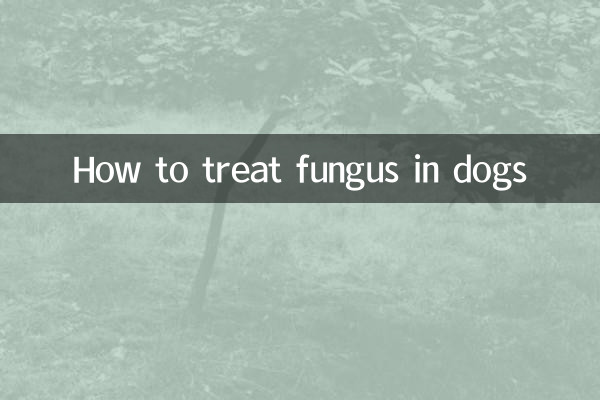How to treat fungus in dogs
Recently, the topic of pet health has continued to heat up on major social platforms and forums, especially the treatment of fungal infections in dogs has become a hot topic of discussion. The following is a structured data analysis article, combined with the hot content of the entire Internet in the past 10 days, to provide you with detailed answers to the treatment options for fungal infections in dogs.
1. Common symptoms of fungal infections in dogs

Fungal infection is one of the most common skin diseases in dogs and usually presents with the following symptoms:
| symptom | describe |
|---|---|
| Red and swollen skin | Red patches or swelling in the infected area |
| hair removal | Partial hair loss, forming round bald spots |
| itching | The dog scratches or licks the affected area frequently |
| dandruff | White or gray scales appear on the skin surface |
| Odor | The infected area may have a bad smell |
2. Common causes of fungal infections
According to recent pet health reports, the leading causes of fungal infections in dogs include:
| reason | Proportion |
|---|---|
| Humid environment | 35% |
| low immunity | 25% |
| exposure to infection | 20% |
| Poor sanitary conditions | 15% |
| other reasons | 5% |
3. Comparison of mainstream treatment methods
The following is a comparative analysis of several treatment methods recently recommended by pet doctors:
| Treatment | advantage | shortcoming | Applicable situations |
|---|---|---|---|
| Topical antifungal ointments | Quick effect, few side effects | Requires frequent application | local small area infection |
| Oral antifungal medications | systemic treatment | may have side effects | Extensive or severe infection |
| Medicinal bath | Large area cleaning | Troublesome to operate | systemic infection |
| naturopathy | No chemicals | Slow results | mild infection |
4. Recent popular treatment options
According to popular discussions on major pet forums, the following treatment options receive the most attention:
(1)Comprehensive therapy: Combining topical and oral medications, along with medicated baths, is considered to be the most effective treatment option at present.
(2)New antifungal spray: Several sprays recently launched have been widely praised for their ease of use and quick results.
(3)immune boosting therapy: Supplement vitamins and probiotics during treatment to improve the dog’s own immunity and prevent recurrence.
5. Precautions
Prevention is better than cure. Here are the prevention points recently emphasized by pet experts:
| Precautions | Specific methods |
|---|---|
| keep dry | Dry the dog bed mat regularly to keep the living environment dry |
| Regular cleaning | Brush your dog at least 2-3 times a week to keep his skin clean |
| Nutritionally balanced | Provide foods rich in vitamins and protein |
| avoid contact | Reduce contact with sick animals |
| Regular inspection | Check skin condition once a month |
6. Recent hot and controversial topics
(1)Whether to shave: There has been a heated discussion recently about whether you should shave when you have a fungal infection. Some experts believe that shaving helps drug absorption, while others believe that it may cause secondary harm.
(2)antibiotic use: Different doctors have given completely different advice on whether antibiotics need to be used together.
(3)treatment cycle: For mild infections, there is currently no unified standard for whether a 2-4 week treatment cycle is sufficient.
7. Sharing the experience of shit shoveling officers
According to recent user sharings in popular pet communities, the following experiences are worth learning from:
(1) Wear an Elizabethan collar on the dog during treatment to prevent licking the drug.
(2) Use UV light to disinfect your dog’s living area weekly.
(3) Avoid bathing your dog too frequently during treatment to avoid damaging the skin barrier.
(4) Insist on completing the entire course of treatment, and continue taking the medication for 1-2 weeks even if the symptoms disappear.
Conclusion
Although fungal infections in dogs are common, they are completely treatable with prompt and correct treatment. Recent hot topics of discussion show that comprehensive therapy combined with good preventive measures is the most recommended solution. No matter which treatment method is chosen, it is recommended to carry out it under the guidance of a professional veterinarian and pay close attention to the dog's reaction. I hope this article can provide you with valuable reference information and wish your dog a speedy recovery!

check the details

check the details